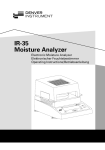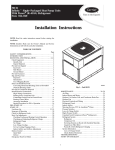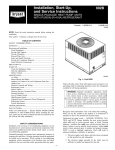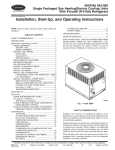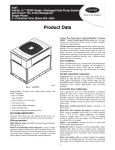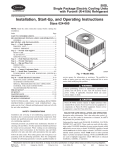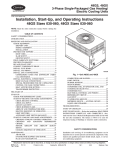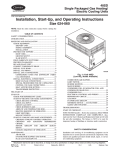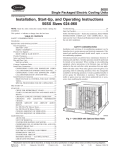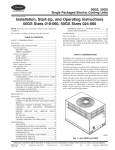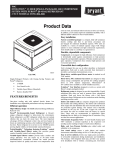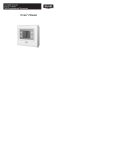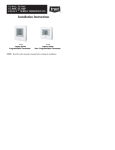Download Carrier 50SD Instruction manual
Transcript
50SD Legacyt Single--Packaged Air Conditioner System With R--22 Refrigerant Single-- and Three--Phase Units Sizes 024--060 Installation Instructions NOTE: Read the entire instruction manual before starting the installation. NOTE: Installer: Make sure the Owner’s Manual and Service Instructions are left with the unit after installation. TABLE OF CONTENTS Page SAFETY CONSIDERATIONS . . . . . . . . . . . . . . . . . . . . . . . . 1 INTRODUCTION . . . . . . . . . . . . . . . . . . . . . . . . . . . . . . . . . . 2 RECEIVING AND INSTALLATION . . . . . . . . . . . . . . . . . 2--9 Check Equipment . . . . . . . . . . . . . . . . . . . . . . . . . . . . . . . . . 2 Identify Unit . . . . . . . . . . . . . . . . . . . . . . . . . . . . . . . . . . . 2 Inspect Shipment . . . . . . . . . . . . . . . . . . . . . . . . . . . . . . . . 2 Provide Unit Support . . . . . . . . . . . . . . . . . . . . . . . . . . . . . . 2 Roof Curb . . . . . . . . . . . . . . . . . . . . . . . . . . . . . . . . . . . . . 2 Slab Mount . . . . . . . . . . . . . . . . . . . . . . . . . . . . . . . . . . . . 2 Ground Mount . . . . . . . . . . . . . . . . . . . . . . . . . . . . . . . . . 2 Provide Clearances . . . . . . . . . . . . . . . . . . . . . . . . . . . . . . . . 2 Field Fabricate Ductwork . . . . . . . . . . . . . . . . . . . . . . . . . . . 2 Rig and Place Unit . . . . . . . . . . . . . . . . . . . . . . . . . . . . . . . . 2 Inspection . . . . . . . . . . . . . . . . . . . . . . . . . . . . . . . . . . . . . 2 Installation . . . . . . . . . . . . . . . . . . . . . . . . . . . . . . . . . . . . . 6 Use of Rigging Bracket . . . . . . . . . . . . . . . . . . . . . . . . . . . 6 Connect Condensate Drain . . . . . . . . . . . . . . . . . . . . . . . . . . 7 Install Duct Connections . . . . . . . . . . . . . . . . . . . . . . . . . . . . 7 Configuring Units for Downflow (Vertical) Discharge . . . . . 7 Install Electrical Connections . . . . . . . . . . . . . . . . . . . . . . . . 8 High--Voltage Connections . . . . . . . . . . . . . . . . . . . . . . . . 9 Special Procedures for 208v Operation . . . . . . . . . . . . . . . 9 Control Voltage Connections . . . . . . . . . . . . . . . . . . . . . . . 9 Standard Connection . . . . . . . . . . . . . . . . . . . . . . . . . . . . . 9 Transformer Protection . . . . . . . . . . . . . . . . . . . . . . . . . . . 9 PRE--START--UP . . . . . . . . . . . . . . . . . . . . . . . . . . . . . . . . . . 10 START--UP . . . . . . . . . . . . . . . . . . . . . . . . . . . . . . . . . . . . 11--16 Check for Refrigerant Leaks . . . . . . . . . . . . . . . . . . . . . . . . 11 Start--Up Adjustments . . . . . . . . . . . . . . . . . . . . . . . . . . . . . 11 Checking Cooling Control Operation . . . . . . . . . . . . . . . 11 Checking and Adjusting Refrigerant Charge . . . . . . . . . . 11 Indoor Airflow and Airflow Adjustments . . . . . . . . . . . . 11 Cooling Sequence of Operation . . . . . . . . . . . . . . . . . . . . 16 MAINTENANCE . . . . . . . . . . . . . . . . . . . . . . . . . . . . . . . 16--18 Air Filter . . . . . . . . . . . . . . . . . . . . . . . . . . . . . . . . . . . . . . . 17 Indoor Blower and Motor . . . . . . . . . . . . . . . . . . . . . . . . . . 17 Outdoor Coil, Indoor Coil, and Condensate Drain Pan . . . . 17 Outdoor Fan . . . . . . . . . . . . . . . . . . . . . . . . . . . . . . . . . . . . 18 Electrical Controls and Wiring . . . . . . . . . . . . . . . . . . . . . . 18 Refrigerant Circuit . . . . . . . . . . . . . . . . . . . . . . . . . . . . . . . . 18 Indoor Airflow . . . . . . . . . . . . . . . . . . . . . . . . . . . . . . . . . . 18 Metering Devices–AccuRater® Piston . . . . . . . . . . . . . . . . 18 TROUBLESHOOTING . . . . . . . . . . . . . . . . . . . . . . . . . . . . . 18 START--UP CHECKLIST . . . . . . . . . . . . . . . . . . . . . . . . . . . 18 C99001 Fig. 1 -- Unit 50SD SAFETY CONSIDERATIONS Installation and servicing of this equipment can be hazardous due to mechanical and electrical components. Only trained and qualified personnel should install, repair, or service this equipment. Untrained personnel can perform basic maintenance functions such as cleaning and replacing air filters. All other operations must be performed by trained service personnel. When working on this equipment, observe precautions in the literature, on tags, and on labels attached to or shipped with the unit and other safety precautions that may apply. Follow all safety codes. Installation must be in compliance with local and national building codes. Wear safety glasses, protective clothing, and work gloves. Have fire extinguisher available. Read these instructions thoroughly and follow all warnings or cautions included in literature and attached to the unit. Recognize safety information. This is the safety--alert symbol . When you see this symbol on the unit and in instructions or manuals, be alert to the potential for personal injury. Understand these signal words: DANGER, WARNING, and CAUTION. These words are used with the safety--alert symbol. DANGER identifies the most serious hazards which will result in severe personal injury or death. WARNING signifies hazards which could result in personal injury or death. CAUTION is used to identify unsafe practices which may result in minor personal injury or product and property damage. NOTE is used to highlight suggestions which will result in enhanced installation, reliability, or operation. 1 ! recirculate to the outdoor coil. Do not locate the unit in either a corner or under an overhead obstruction. The minimum clearance under a partial overhang (such as a normal house overhang) is 48 in. above the unit top. The maximum horizontal extension of a partial overhang must not exceed 48 in. WARNING ELECTRICAL SHOCK HAZARD Failure to follow this warning could result in personal injury or death. IMPORTANT: Do not restrict outdoor airflow. An air restriction at either the outdoor--air inlet or the fan discharge may be detrimental to compressor life. Before installing or servicing system, always turn off main power to system. There may be more than one disconnect switch. Turn off accessory heater power switch if applicable. Do not place the unit where water, ice, or snow from an overhang or roof will damage or flood the unit. Do not install the unit on carpeting or other combustible materials. Slab--mounted units should be at least 4 in. above the highest expected water and runoff levels. Do not use unit if it has been under water. 50SD INTRODUCTION The 50SD packaged air conditioner is fully self--contained and designed for outdoor installation (See Fig. 1). See Fig. 2 and 3 for unit dimensions. All unit sizes have discharge openings for both horizontal and downflow configurations, and are factory shipped with all downflow duct openings covered. The unit may be installed either on a rooftop, gound--level cement slab, or directly on the gound if local codes permit. (See Fig. 4 for roof curb dimensions.) Step 4—Field--Fabricate Ductwork Secure all ducts to roof curb and building structure on vertical discharge units. Do not connect ductwork to unit. For horizontal applications, unit is provided with flanges on the horizontal openings. All ductwork should be secured to the flanges. Insulate and weatherproof all external ductwork, joints, and roof openings with counter flashing and mastic in accordance with applicable codes. RECEIVING AND INSTALLATION Step 1—Check Equipment IDENTIFY UNIT Ducts passing through an unconditioned space must be insulated and covered with a vapor barrier. If a plenum return is used on a vertical unit, the return should be ducted through the roof deck to comply with applicable fire codes. A minimum clearance is not required around ductwork. Cabinet return--air static shall not exceed --.25 in. wc. The unit model number and serial number are printed on the unit informative plate. Check this information against shipping papers. INSPECT SHIPMENT Inspect for shipping damage while unit is still on shipping pallet. If unit appears to be damaged or is torn loose from its anchorage, have it examined by transportation inspectors before removal. Forward claim papers directly to transportation company. Manufacturer is not responsible for any damage incurred in transit. Check all items against shipping list. Immediately notify the nearest Carrier Air Conditioning office if any item is missing. To prevent loss or damage, leave all parts in original packages until installation. Step 5—Rig and Place Unit Rigging and handling of this equipment can be hazardous for many reasons due to the installation location (roofs, elevated structures, etc.). Only trained, qualified crane operators and ground support staff should handle and install this equipment. Step 2—Provide Unit Support When working with this equipment, observe precautions in the literature, on tags, stickers, and labels attached to the equipment, and any other safety precautions that might apply. For hurricane tie downs, contact distributor for details and PE (Professional Engineering) Certificate if required. ROOF CURB Training for operators of the lifting equipment should include, but not be limited to, the following: Install accessory roof curb in accordance with instructions shipped with curb (See Fig. 4). Install insulation, cant strips, roofing, and flashing. Ductwork must be attached to curb. 1. Application of the lifter to the load, and adjustment of the lifts to adapt to various sizes or kinds of loads. 2. Instruction in any special operation or precaution. IMPORTANT: The gasketing of the unit to the roof curb is critical for a water tight seal. Install gasketing material supplied with the roof curb. Improperly applied gasketing also can result in air leaks and poor unit performance. 3. Condition of the load as it relates to operation of the lifting kit, such as balance, temperature, etc. Follow all applicable safety codes. Wear safety shoes and work gloves. Curb should be level to within 1/4 in. (See Fig. 6). This is necessary for unit drain to function properly. Refer to accessory roof curb installation instructions for additional information as required. INSPECTION Prior to initial use, and at monthly intervals, all rigging brackets and straps should be visually inspected for any damage, evidence of wear, structural deformation, or cracks. Particular attention should be paid to excessive wear at hoist hooking points and load support areas. Brackets or straps showing any kind of wear in these areas must not be used and should be discarded. SLAB MOUNT Place the unit on a solid, level concrete pad that is a minimum of 4 in. thick with 2 in. above grade. The slab should extend approximately 2 in. beyond the casing on all 4 sides of the unit (See Fig. 7). Do not secure the unit to the slab except when required by local codes. ! GROUND MOUNT The unit may be installed either on a slab or placed directly on the ground if local codes permit. Place the unit on level ground prepared with gravel for condensate discharge. WARNING ELECTRICAL SHOCK HAZARD Failure to follow this warning could result in personal injury or death. Step 3—Provide Clearances Before installing or servicing system, always turn off main power to system. There may be more than one disconnect switch. Turn off accessory heater power switch if applicable. Tag disconnect switch with a suitable warning label. The required minimum service clearances are shown in Fig. 2 and 3. Adequate ventilation and outdoor air must be provided. The outdoor fan draws air through the outdoor coil and discharges it through the top fan grille. Be sure that the fan discharge does not 2 50SD REQUIRED CLEARANCE FOR OPERATION AND SERVICING REQUIRED CLEARANCE TO COMBUSTIBLE MATL. (Refer to Maximum Operating Clearances) INCHES [mm] TOP OF UNIT...................................................................................14.00 [355.6] DUCT SIDE OF UNIT.........................................................................2.00 [50.8] SIDE OPPOSITE DUCTS ................................................................14.00 [355.6] BOTTOM OF UNIT .............................................................................0.50 [12.7] INCHES [mm] EVAP. COIL ACCESS SIDE............................................................36.00 [914.0] POWER ENTRY SIDE....................................................................42.00 [1066.8] (EXCEPT FOR NEC REQUIREMENTS) UNIT TOP .......................................................................................48.00 [1219.2] SIDE OPPOSITE DUCTS ..............................................................36.00 [914.0] DUCT PANEL .................................................................................12.00 [304.8] * NEC. REQUIRED CLEARANCES. *MINIMUM DISTANCES: IF UNIT IS PLACED LESS THAN 304.8 [12.00] FROM WALL SYSTEM, THEN SYSTEM PERFORMANCE MAYBE COMPROMISE. INCHES [mm] BETWEEN UNITS, POWER ENTRY SIDE ....................................42.00 [1066.8] UNIT AND UNGROUNDED SURFACES, POWER ENTRY SIDE .36.00 [914.0] UNIT AND BLOCK OR CONCRETE WALLS AND OTHER GROUNDED SURFACES, POWER ENTRY SIDE.........................42.00 [1066.8] A05162 UNIT HEIGHT IN. [MM] “A” UNIT WEIGHT UNIT ELECTRICAL CHARACTERISTICS 50SD024 50SD030 208/230--1--60 208/230--1--60, 208/230--3--60 lb 343 366 kg 156 166 39.02 [991] 41.02 [1042] Fig. 2 -- 50SD024--030 Unit Dimensions 3 CENTER OF GRAVITY IN. [MM] X Y Z 20.0 [508] 19.3 [490] 17.6 [447] 20.0 [508] 14.0 [356] 13.0 [330] 50SD REQUIRED CLEARANCE TO COMBUSTIBLE MATL. (Refer to Maximum Operating Clearances) REQUIRED CLEARANCE FOR OPERATION AND SERVICING INCHES [mm] TOP OF UNIT...................................................................................14.00 [355.6] DUCT SIDE OF UNIT.........................................................................2.00 [50.8] SIDE OPPOSITE DUCTS ................................................................14.00 [355.6] BOTTOM OF UNIT .............................................................................0.50 [12.7] INCHES [mm] EVAP. COIL ACCESS SIDE............................................................36.00 [914.0] POWER ENTRY SIDE....................................................................42.00 [1066.8] (EXCEPT FOR NEC REQUIREMENTS) UNIT TOP .......................................................................................48.00 [1219.2] SIDE OPPOSITE DUCTS ..............................................................36.00 [914.0] DUCT PANEL .................................................................................12.00 [304.8] * NEC. REQUIRED CLEARANCES. *MINIMUM DISTANCES: IF UNIT IS PLACED LESS THAN 304.8 [12.00] FROM WALL SYSTEM, THEN SYSTEM PERFORMANCE MAYBE COMPROMISE. INCHES [mm] BETWEEN UNITS, POWER ENTRY SIDE ....................................42.00 [1066.8] UNIT AND UNGROUNDED SURFACES, POWER ENTRY SIDE .36.00 [914.0] UNIT AND BLOCK OR CONCRETE WALLS AND OTHER GROUNDED SURFACES, POWER ENTRY SIDE.........................42.00 [1066.8] A05126 UNIT 50SD036 50SD042 50SD048 50SD060 ELECTRICAL CHARACTERISTICS 208/230--1--60, 208/230--1--60, 208/230--1--60, 208/230--1--60, 208/230--3--60, 208/230--3--60, 208/230--3--60, 208/230--3--60, 460--3--60 460--3--60 460--3--60 460--3--60 UNIT WEIGHT lb 433 460 480 492 kg 196 209 218 223 UNIT HEIGHT IN. [MM] “A” 42.98 [1092] 46.98 [1193] 46.98 [1193] 46.98 [1193] Fig. 3 -- 50SD036--060 Unit Dimensions 4 CENTER OF GRAVITY IN. [MM] X Y Z 21.0 [533] 20.5 [520] 16.6 [422] 21.0 [533] 20.5 [520] 17.1 [434] 21.0 [533] 20.0 [508] 17.4 [442] 21.0 [533] 20.0 [508] 17.6 [447] HVAC unit base HVAC unit base Screw (NO TE A) Gask eting inner flange* Screw (NOTE A) Gasketing inner flange* *Gasketing outer flange *Gasketing outer flange Wood nailer* Wood nailer* Flashing field supplied Roof curb* Insulation (field supplied) Roofing material field supplied Insulation (field supplied) Roofing material field supplied Ductwork field supplied Cant strip field supplied Roof curb* Ductwork field supplied Cant strip field supplied Roof Roof *Provided with roof curb *Provided with roof curb Roof Curb for Small Cabinet Roof Curb for Large Cabinet Note A: When unit mounting scre w is used, retainer bracket must also be used. Note A: When unit mounting scre w is used, retainer bracket must also be used. E G Supply opening (B x C) G B Typ. F F D CTyp. R/A S/A A E Insulated deck pan 50SD Flashing field supplied Gasket around duct D Insulated deck pan Short Support Gasket around outer edge Long Support Return opening (B X C) A05308 UNIT SIZE 50SD024-- 030 50SD036-- 060 ODS CATALOG NUMBER CPRFCURB006A00 CPRFCURB007A00 CPRFCURB008A00 CPRFCURB009A00 A IN. (MM) 8 (203) 14 (356) 8 (203) 14 (356) B IN. (MM) 11 (279) 11 (279) 16--3/16 (411) 16--3/16 (411) C IN. (MM) 16--1/2 (419) 16--1/2 (419) 17--3/8 (441) 17--3/8 (441) D IN. (MM) 28--3/4 (730) 28--3/4 (730) 40--1/4 (1022) 40--1/4 (1022) E IN. (MM) 30--3/8 (771) 30--3/8 (771) 41--15/16 (1065) 41--15/16 (1065) F IN. (MM) 44--5/16 (1126) 44--5/16 (1126) 44--7/16 (1129) 44--7/16 (1129) G IN. (MM) 45--15/16 (1167) 45--15/16 (1167) 46--1/16 (1169) 46--1/16 (1169) NOTES: 1. Roof curb must be set up for unit being installed. 2. Seal strip must be applied, as required, to unit being installed. 3. Dimensions are in inches. 4. Dimension in ( ) are in millimeters. 5. Roof curb is made of 16--gauge steel. 6. Attach ductwork to curb (flanges of duct rest on curb). 7. Insulated panels: 1--in. thick fiberglass 1 lb. density. 8. When unit mounting screw is used (see Note A), a retainer bracket must be used as well. This bracket must also be used when required by code for hurricane or seismic conditions. This bracket is available through Micrometl. Fig. 4 -- Roof Curb Dimensions 5 1 2 y DETAIL A 4 3 x 50SD C00071 A05161 CORNER WEIGHTS (SMALL CABINET) CORNER WEIGHTS (LARGE CABINET) Unit 024 030 Unit 036 042 048 060 Total Weight 343 366 Total Weight 433 460 480 492 Corner Weight 1 69 74 Corner Weight 1 87 93 97 99 Corner Weight 2 53 57 Corner Weight 2 68 72 74 76 Corner Weight 3 83 88 Corner Weight 3 104 111 116 119 Corner Weight 4 138 147 Corner Weight 4 174 184 193 198 Rigging Weight 353 376 Rigging Weight 443 470 490 502 Fig. 5 -- 50SD Unit Corner Weights (in Pounds) and Suggested Rigging ! WARNING UNIT FALLING HAZARD A Failure to follow this warning could result in personal injury or death. C MAXIMUM ALLOWABLE DIFFERENCE (in.) B Never stand beneath rigged units or lift over people. A-B B-C A-C INSTALLATION 1/4 1/4 1/4 The lifting/rigging bracket is engineered and designed to be installed only on Small Packaged Products. This bracket is to be used to rig/lift a Small Packaged Product onto roofs or other elevated structures. C99065 Fig. 6 -- Unit Leveling Tolerances ! OPTIONAL RETURN AIR OPENING OPTIONAL SUPPLY AIR OPENING WARNING PROPERTY DAMAGE HAZARD Failure to follow this warning could result in personal injury/death or property damage. Rigging brackets for one unit use only. When removing a unit at the end of its useful life, use a new set of brackets. USE OF RIGGING BRACKET 2" Field Installation of Rigging Bracket EVAP. COIL 1. If applicable, remove unit from shipping carton. Leave top shipping skid on the unit for use as a spreader bar to prevent the rigging straps from damaging the unit. If the skid is not available, use a spreader bar of sufficient length to protect the unit from damage. COND. COIL C99096 Fig. 7 -- Slab Mounting Detail 2. Remove 4 screws in unit corner posts. 6 3. Attach each of the 4 metal rigging brackets under the panel rain lip (See Fig. 5). Use the screws removed in step 2 above to secure the brackets to the unit. 1” (25mm) MIN. WARNING TRAP OUTLET 2” (50mm) MIN. PROPERTY DAMAGE HAZARD Failure to follow this warning could result in personal injury/death or property damage. C99013 Fig. 8 -- Condensate Trap Rigging bracket MUST be under the rain lip to provide adequate lifting. ! Step 7—Install Duct Connections The design and installation of the duct system must be in accordance with the standards of the NFPA for installation of non--residence type air conditioning and ventilating systems, NFPA 90A or residence type, NFPA 90B and/or local codes and ordinances. WARNING PROPERTY DAMAGE HAZARD Select and size ductwork, supply--air registers, and return air grilles according to ASHRAE (American Society of Heating, Refrigeration, and Air Conditioning Engineers) recommendations. The unit has duct flanges on the supply-- and return--air openings on the side of the unit. Failure to follow this warning could result in personal injury/death or property damage. Do not strip screws when re--securing the unit. If a screw is stripped, replace the stripped one with a larger diameter screw (included). When designing and installing ductwork, consider the following: Rigging/Lifting of Unit 1. All units should have field--supplied filters or accessory filter rack installed in the return--air side of the unit. Recommended sizes for filters are shown in Table 1. 1. Bend top of brackets down approximately 30 degrees from the corner posts. 2. Avoid abrupt duct size increases and reductions. Abrupt change in duct size adversely affects air performance. 2. Attach straps of equal length to the rigging brackets at opposite ends of the unit. Be sure straps are rated to hold the weight of the unit (See Fig. 5). IMPORTANT: Use flexible connectors between ductwork and unit to prevent transmission of vibration. Use suitable gaskets to ensure weather--tight and airtight seal. When electric heat is installed, use fireproof canvas (or similar heat resistant material) connector between ductwork and unit discharge connection. If flexible duct is used, insert a sheet metal sleeve inside duct. Heat resistant duct connector (or sheet metal sleeve) must extend 24--in. from electric heater element. 3. Attach a clevis of sufficient strength in the middle of the straps. Adjust the clevis location to ensure unit is lifted level with the ground. 4. After unit is securely in place detach rigging straps. Remove corner posts, screws, and rigging brackets then reinstall screws. ! WARNING 3. Size ductwork for cooling air quantity (cfm). The minimum air quantity for proper electric heater operation is listed in Table 2. Heater limit switches may trip at air quantities below those recommended. UNIT FALLING HAZARD Failure to follow this warning could result in personal injury/death or property damage. 4. Seal, insulate, and weatherproof all external ductwork. Seal, insulate and cover with a vapor barrier all ductwork passing through conditioned spaces. Follow latest Sheet Metal and Air Conditioning Contractors National Association (SMACNA) and Air Conditioning Contractors Association (ACCA) minimum installation standards for residential heating and air conditioning systems. When straps are taut, the clevis should be a minimum of 36 inches above the unit top cover. After the unit is placed on the roof curb or mounting pad, remove the top crating. Step 6—Connect Condensate Drain NOTE: When installing condensate drain connection be sure to comply with local codes and restrictions. 5. Secure all ducts to building structure. Flash, weatherproof, and vibration--isolate duct openings in wall or roof according to good construction practices. Model 50SD disposes of condensate water through a 3/4 in. NPT fitting which exits through the base on the evaporator coil access side. See Fig. 2 & 3 for location. CONFIGURING UNITS FOR DOWNFLOW (VERTICAL) DISCHARGE Condensate water can be drained directly onto the roof in rooftop installations (where permitted) or onto a gravel apron in ground level installations. Install a field--supplied condensate trap at end of condensate connection to ensure proper drainage. Make sure that the outlet of the trap is at least 1 in. lower than the drain pan condensate connection to prevent the pan from overflowing (See Fig. 8). When using a gravel apron, make sure it slopes away from the unit. ! WARNING ELECTRICAL SHOCK HAZARD Failure to follow this warning could result in personal injury or death. Before performing service or maintenance operations on the system, turn off main power to unit and install lockout tag. Connect a drain tube using a minimum of 3/4 --in. PVC or 3/4 --in. copper pipe (all field--supplied) at the outlet end of the 2--in. trap. Do not undersize the tube. Pitch the drain tube downward at a slope of at least 1--in. for every 10 ft of horizontal run. Be sure to check the 1. Open all electrical disconnects and install lockout tag before starting any service work. 7 50SD ! drain tube for leaks. Prime trap at the beginning of the cooling season start--up. 2. Remove return duct cover located on duct panel by breaking four (4) connecting tabs with screwdriver and a hammer (See Fig. 9 & 10). 3. To remove supply duct cover, break front and right side connecting tabs with a screwdriver and a hammer. Push louver down to break rear and left side tabs (See Fig. 9 & 10). 4. If unit ductwork is to be attached to vertical opening flanges on the unit composite base (jackstand applications only), do so at this time. Collect ALL screws that were removed. Do not leave screws on rooftop as permanent damage to the roof may occur. 50SD 5. It is recommended that the unit base insulation around the perimeter of the vertical return--air opening be secured to the unit base with aluminum tape. Applicable local codes may require aluminum tape to prevent exposed fiberglass. RETURN DUCT OPENING SUPPLY DUCT OPENING 6. Cover both horizontal duct openings with the duct covers from the accessory duct cover kit. Ensure opening is air--and watertight. C99011 Fig. 9 -- Supply and Return Duct Opening 7. After completing unit conversion, perform all safety checks and power up unit. NOTE:The design and installation of the duct system must be in accordance with the standards of the NFPA for installation of nonresidence--type air conditioning and ventilating systems, NFPA 90A or residence--type, NFPA 90B; and/or local codes and ordinances. Adhere to the following criteria when selecting, sizing, and installing the duct system: 1. Units are shipped for side shot installation. 2. Select and size ductwork, supply--air registers, and return--air grilles according to American Society of Heating, Refrigeration and Air Conditioning Engineers (ASHRAE) recommendations. 3. Use flexible transition between rigid ductwork and unit to prevent transmission of vibration. The transition may be screwed or bolted to duct flanges. Use suitable gaskets to ensure weather--tight and airtight seal. DUCT COVERS REMOVED C99012 Fig. 10 -- Vertical Duct Cover Removed 4. All units must have field--supplied filters or accessory filter rack installed in the return--air side of the unit. Recommended sizes for filters are shown in Table 1. Step 8—Install Electrical Connections ! 5. Size all ductwork for maximum required airflow (either heating or cooling) for unit being installed. Avoid abrupt duct size increases or decreases or performance may be affected. WARNING ELECTRICAL SHOCK HAZARD Failure to follow this warning could result in personal injury or death. 6. Adequately insulate and weatherproof all ductwork located outdoors. Insulate ducts passing through unconditioned space, and use vapor barrier in accordance with latest issue of Sheet Metal and Air Conditioning Contractors National Association (SMACNA) and Air Conditioning Contractors of America (ACCA) minimum installation standards for heating and air conditioning systems. Secure all ducts to building structure. The unit cabinet must have an uninterrupted, unbroken electrical ground to minimize the possibility of personal injury if an electrical fault should occur. This ground may consist of an electrical wire connected to the unit ground screw in the control compartment, or conduit approved for electrical ground when installed in accordance with NEC, ANSI/NFPA American National Standards Institute/National Fire Protection Association (latest edition) (in Canada, Canadian Electrical Code CSA C22.1) and local electrical codes. 7. Flash, weatherproof, and vibration--isolate all openings in building structure in accordance with local codes and good building practices. 8 SPECIAL PROCEDURES FOR 208--V OPERATION CAUTION ! UNIT COMPONENT DAMAGE HAZARD WARNING ELECTRICAL SHOCK HAZARD Failure to follow this caution may result in damage to the unit being installed. Failure to follow this warning could result in personal injury or death. 1. Make all electrical connections in accordance with NEC ANSI/NFPA (latest edition) and local electrical codes governing such wiring. In Canada, all electrical connections must be in accordance with CSA standard C22.1 Canadian Electrical Code Part 1 and applicable local codes. Refer to unit wiring diagram. Make sure that the power supply to the unit is switched OFF and lockout tag installed before making any wiring changes. CONTROL VOLTAGE CONNECTIONS NOTE:Do not use any type of power--stealing thermostat. Unit control problems may result. 2. Use only copper conductor for connections between field--supplied electrical disconnect switch and unit. DO NOT USE ALUMINUM WIRE. Use no. 18 American Wire Gage (AWG) color--coded, insulated (35° C minimum) wires to make the control voltage connections between the thermostat and the unit. If the thermostat is located more than 100 ft from the unit (as measured along the control voltage wires), use no. 16 AWG color--coded, insulated (35° C minimum) wires. 3. Be sure that high--voltage power to unit is within operating voltage range indicated on unit rating plate. On 3--phase units, ensure phases are balanced within 2 percent. Consult local power company for correction of improper voltage and/or phase imbalance. STANDARD CONNECTION 4. Do not damage internal components when drilling through any panel to mount electrical hardware, conduit, etc. Remove knockout hole located in the electric heat panel adjacent to the control access panel. See Fig. 2 & 3. Remove the rubber grommet from the installer’s packet (included with unit) and install grommet in the knockout opening. Provide a drip loop before running wire through panel. HIGH--VOLTAGE CONNECTIONS The unit must have a separate electrical service with a field--supplied, waterproof disconnect switch mounted at, or within sight from the unit. Refer to the unit rating plate, NEC and local codes for maximum fuse/circuit breaker size and minimum circuit amps (ampacity) for wire sizing. Run the low--voltage leads from the thermostat, through the inlet hole, and into unit low--voltage splice box. Locate five 18--gage wires leaving control box. These low--voltage connection leads can be identified by the colors red, green, yellow, brown (See Fig. 11). Ensure the leads are long enough to be routed into the low--voltage splice box (located below right side of control box). Stripped yellow wire is located in connection box. Route leads through hole in bottom of control box and make low--voltage connections (See Fig. 11). Secure all cut wires, so that they do not interfere with operation of unit. The field--supplied disconnect may be mounted on the unit over the high--voltage inlet hole when the standard power and low--voltage entry points are used. See Fig. 2 and 3 for acceptable location. See unit wiring label and Fig. 11 for reference when making high voltage connections. Proceed as follows to complete the high--voltage connections to the unit. Single phase units: TRANSFORMER PROTECTION 1. Run the high--voltage (L1, L2) and ground lead into the control box. The transformer is of the energy--limiting type. It is set to withstand a 30--second overload or shorted secondary condition. 2. Connect ground lead to chassis ground connection. 3. Locate the black and yellow wires connected to the line side of the contactor. HIGH VOLTAGE POWER LEADS (SEE UNIT WIRING LABEL) 4. Connect field L1 to black wire on connection 11 of the compressor contactor. POWER SUPPLY 5. Connect field wire L2 to yellow wire on connection 23 of the compressor contactor. Three--phase units: GND FIELD-SUPPLIED FUSED DISCONNECT CONTROL BOX 1. Run the high--voltage (L1, L2, L3) and ground lead into the control box. YEL(Y) 2. Connect ground lead to chassis ground connection. GRN(G) LOW-VOLTAGE POWER LEADS (SEE UNIT WIRING LABEL) 3. Locate the black and yellow wires connected to the line side of the contactor. 4. Connect field L1 to black wire on connection 11 of the compressor contactor. RED(R) BRN(C) Y G THERMOSTAT (TYPICAL) R C SPLICE BOX 5. Connect field wire L2 to yellow wire on connection 13 of the compressor contactor. LEGEND Field Control-Voltage Wiring Field High-Voltage Wiring NOTE: Use blue wire for 3-phase units only. 6. Connect field wire L3 to blue wire from compressor. C99010 Fig. 11 -- High-- and Control--Voltage Connections 9 50SD ! 50SD Table 1—Physical Data--Unit 50SD UNIT SIZE 024 030 036 042 048 060 NOMINAL CAPACITY (ton) 2 2--1/2 3 3--1/2 4 5 OPERATING WEIGHT (lb.) 289 312 371 398 418 430 COMPRESSOR Scroll REFRIGERANT (R--22) Quantity (lb.) 7.8 8.2 10.7 10.8 12.1 11.8 REFRIGERANT METERING DEVICE AccuRater® ORIFICE OD (in.) 0.065 0.070 0.080 0.088 0.088 0.101 OUTDOOR COIL Rows…Fins/in. 2…21 2…21 2…21 2…21 2…21 2…21 Face Area (sq. ft.) 11.9 13.6 15.5 19.4 19.4 19.4 OUTDOOR FAN Nominal Cfm 2700 2700 2800 2800 3300 3300 Diameter 22 22 22 22 22 22 Motor HP (RPM) 1/8 (825) 1/8 (825) 1/8 (825) 1/8 (825) 1/4 (1100) 1/4 (1100) INDOOR COIL Rows…Fins/in. 3…17 3…17 3…17 3…17 3…17 4…17 Face Area (sq. ft.) 3.7 3.7 4.7 4.7 5.6 5.6 INDOOR BLOWER Nominal Airflow (Cfm) 800 1000 1200 1400 1600 1750 Size (in.) 10x10 10x10 11x10 11x10 11x10 11x10 Motor HP (RPM) 1/3 (1050) 1/3 (1050) 1/2 (1000) 1/2 (1075) 1/2 (1075) 1.0 (1040) RETURN--AIR FILTERS (IN.)* 20x24x1 20x24x1 24x36x1 24x36x1 24x36x1 24x36x1 Throwaway *Required filter sizes shown are based on the larger of the ARI (Air Conditioning and Refrigeration Institute) rated cooling airflow or the heating airflow velocity of 300 ft/minute for throwaway type. For permanent filters, follow filter manufacturer’s recommendations for filter size based on allowable face velocity. Air filter pressure drop for non ---standard filters must not exceed 0.08 in. wc. Table 2—Minimum Airflow for Safe Electric Heater Operation (Cfm) SIZE Cfm 024 800 030 1000 036 1200 042 1400 PRE--START--UP ! 048 1600 060 1750 b. Inspect for oil at all refrigerant tubing connections and on unit base. Detecting oil generally indicates a refrigerant leak. Leak test all refrigerant tubing connections using electronic leak detector, or liquid--soap solution. If a refrigerant leak is detected, see following Check for Refrigerant Leaks section. WARNING FIRE, EXPLOSION, ELECTRICAL SHOCK HAZARD Failure to follow this warning could result in personal injury or death and/or property damage. 1. Follow recognized safety practices and wear protective goggles when checking or servicing refrigerant system. 2. Relieve and recover all refrigerant from system before touching or disturbing anything inside terminal box if refrigerant leak is suspected around compressor terminals. 3. Never attempt to repair soldered connection while refrigerant system is under pressure. 4. Do not use torch to remove any component. System contains oil and refrigerant under pressure. 5. To remove a component, wear protective goggles and proceed as follows: a. Shut off electrical power to unit and install lockout tag. b. Relieve and reclaim all refrigerant from system using both high-- and low--pressure ports. c. Cut component connecting tubing with tubing cutter and remove component from unit. d. Carefully unsweat remaining tubing stubs when necessary. Oil can ignite when exposed to torch flame. c. Inspect all field-- and factory--wiring connections. Be sure that connections are completed and tight. d. Ensure wires do not touch refrigerant tubing or sharp sheet metal edges. e. Inspect coil fins. If damaged during shipping and handling, carefully straighten fins with a fin comb. 4. Verify the following conditions: a. Make sure that outdoor fan blade is correctly positioned in fan orifice (See Fig. 12). b. Make sure that condensate drain pan and trap are filled with water to ensure proper drainage. c. Make sure that all tools and miscellaneous loose parts have been removed. FAN GRILLE MOTOR Proceed as follows to inspect and prepare the unit for initial start--up: 1/8" MAX BETWEEN MOTOR AND FAN HUB 1. Remove all access panels. 1/2ý MOTOR SHAFT C99009 2. Read and follow instructions on all DANGER, WARNING, CAUTION, and INFORMATION labels attached to, or shipped with unit. Fig. 12 -- Fan Blade Clearance 3. Make the following inspections: a. Inspect for shipping and handling damages, such as broken lines, loose parts, disconnected wires, etc. 10 CHECK FOR REFRIGERANT LEAKS Proceed as follows to locate and repair a refrigerant leak and to charge the unit: 1. Locate leak and make sure that refrigerant system pressure has been relieved and reclaimed from both high-- and low--pressure ports. 2. Repair leak following accepted practices. NOTE: Install a filter drier whenever the system has been opened for repair. 3. Add a small charge of R--22 refrigerant vapor to system and leak--test unit. 4. Recover refrigerant from system and evacuate to 500 microns if no additional leaks are found. 5. Charge unit with R--22 refrigerant, using a volumetric charging cylinder or accurate scale. Refer to unit rating plate for required charge. Be sure to add extra refrigerant to compensate for internal volume of filter drier. START--UP COOLING ADJUSTMENTS SECTION AND An accurate superheat, thermocouple-- or thermistor--type thermometer, and a gauge manifold are required when using the superheat charging method for evaluating the unit charge. Do not use mercury or small dial--type thermometers because they are not adequate for this type of measurement. NOTE: Allow system to operate for a minimum of 10 minutes before checking or adjusting refrigerant charge. IMPORTANT: When evaluating the refrigerant charge, an indicated adjustment to the specified factory charge must always be very minimal. If a substantial adjustment is indicated, an abnormal condition exists somewhere in the cooling system, such as insufficient airflow across either coil or both coils. Proceed as follows: 1. Remove caps from low-- and high--pressure service fittings. 2. Using hoses with valve core depressors, attach low-- and high--pressure gauge hoses to low-- and high--pressure service fittings, respectively. 3. Start unit and let run until system pressures stabilize. MAKE 4. Measure and record the following: a. Outdoor ambient--air temperature (°F db). Complete the required procedures given in the Pre--Start--Up section before starting the unit. Do not jumper any safety devices when operating the unit. Do not operate the unit when the outdoor temperature is below 40°F (unless accessory low--ambient kit is installed). Do not rapid cycle the compressor. Allow 5 minutes between “on” cycles to prevent compressor damage. CHECKING COOLING CONTROL OPERATION Start and check the unit for proper cooling control operation as follows: 1. Place room thermostat SYSTEM switch in OFF position. Observe that blower motor starts when FAN switch is placed in ON position and shuts down after 30 second fan time delay expires when FAN switch is placed in AUTO position. 2. Place SYSTEM switch in COOL position and FAN switch in AUTO position. Set cooling control below room temperature. Observe that compressor, condenser fan, and evaporator blower motors start. Observe that compressor and outdoor fan shut down when control setting is satisfied and that indoor blower shuts down after 30 second fan time delay expires. IMPORTANT: Three--phase, scroll compressors are direction oriented. Unit must be checked to ensure proper compressor 3--phase power lead orientation. If not corrected within 5 minutes, the internal protector will shut off the compressor. The 3--phase power leads to the unit must be reversed to correct rotation. When turning backwards, the difference between compressor suction and discharge pressures may be dramatically lower than normal. b. Suction--tube temperature (°F) at low--side service fitting. c. Suction (low--side) pressure (psig). 5. Using Cooling Charging Charts compare outdoor--air temperature (°F db) with the suction line pressure (psig) to determine desired system operating suction line temperature (See Fig. 16). 6. Compare actual suction--tube temperature with desired suction--tube temperature. Using a tolerance of ±3°F, add refrigerant if actual temperature is more than 3°F higher than proper suction--tube temperature, or remove refrigerant if actual temperature is more than 3°F lower than required suction--tube temperature. NOTE: If the problem causing the inaccurate readings is a refrigerant leak, refer to Check for Refrigerant Leaks section. INDOOR AIRFLOW AND AIRFLOW ADJUSTMENTS NOTE: For cooling operation, the recommended airflow is 350 to 450 cfm for each 12,000 Btuh of rated cooling capacity. Table 3 shows cooling airflows at various external static pressures. Refer to this table to determine the airflow for the system being installed. NOTE: Be sure that all supply-- and return--air grilles are open, free from obstructions, and adjusted properly. ! CHECKING AND ADJUSTING REFRIGERANT CHARGE WARNING ELECTRICAL SHOCK HAZARD The refrigerant system is fully charged with R--22 refrigerant and is tested and factory sealed. Failure to follow this warning could result in personal injury or death. NOTE: Adjustment of the refrigerant charge is not required unless the unit is suspected of not having the proper R--22 charge. Disconnect electrical power to the unit and install lockout tag before changing blower speed. A superheat charging chart is attached to the outside of the service access panel. The chart includes the required suction line temperature at given suction line pressures and outdoor ambient temperatures. 11 50SD START--UP Table 3—Wet Coil Air Delivery* — Horizontal Discharge (Deduct 10% for 208--Volt Operation) 230 VOLT HORIZONTAL DISCHARGE UNIT SIZE MOTOR SPEED Low 024 Med High Low 030 Med 50SD High Low 036 Med High Low 042 Med High Low 048 Med High Low 060 Med High AIR DELIVERY Watts CFM Watts CFM Watts CFM Watts CFM Watts CFM Watts CFM Watts CFM Watts CFM Watts CFM Watts CFM Watts CFM Watts CFM Watts CFM Watts CFM Watts CFM Watts CFM Watts CFM Watts CFM 0.1 311 935 — — — — 311 935 411 1195 — — 437 1353 — — — — 625 1539 — — — — 627 1550 771 1798 — — 786 2027 873 2095 1012 2184 0.2 309 885 — — — — 309 885 405 1155 — — 433 1318 — — — — 606 1496 741 1738 — — 617 1530 755 1771 — — 769 1960 849 2026 993 2109 0.3 304 820 — — — — 304 820 398 1100 — — 424 1283 — — — — 586 1466 715 1698 — — 607 1493 734 1734 908 2000 754 1901 833 1962 981 2036 EXTERNAL STATIC PRESSURE (IN. WC) 0.4 0.5 0.6 0.7 301 286 — — 757 686 — — — 379 357 357 — 957 868 769 — — — 447 — — — 970 301 — — — 757 — — — 390 379 357 357 1028 957 868 769 — 477 467 447 — 1185 1088 970 417 403 391 379 1235 1187 1123 1059 531 516 496 478 1489 1437 1362 1289 — — — — — — — — 571 550 534 509 1437 1387 1330 1264 694 669 645 610 1653 1604 1538 1457 — — 798 772 — — 1720 1648 584 567 548 528 1461 1414 1361 1320 711 690 665 639 1687 1645 1595 1530 887 858 827 804 1994 1876 1811 1735 736 722 705 684 1821 1759 1693 1616 815 798 782 763 1887 1817 1748 1679 963 948 927 904 1963 1886 1812 1729 0.8 — — 345 647 435 853 — — — — 435 853 362 975 459 1208 629 1470 483 1183 573 1362 738 1540 503 1250 607 1449 767 1647 658 1513 748 1583 886 1647 0.9 — — 327 365 421 712 — — — — — — — — 435 1099 602 1357 457 1093 544 1271 700 1414 — — 572 1355 748 1555 — — — — — — 1.0 — — — — — — — — — — — — — — — — — — — — — — — — — — — — — — — — — — — — *Air delivery values are based on operating voltage of 230v, wet coil, without filter or electric heater. Deduct filter and electric heater pressure drops to obtain static pressure available for ducting. NOTES: 1. Do not operate the unit at a cooling airflow that is less than 350 cfm for each 12,000 Btuh of rated cooling capacity. Evaporator coil frosting may occur at airflows below this point. 2. Dashes indicate portions of table that are beyond the blower motor capacity or are not recommended. 12 50SD A05112 Fig. 13 -- Wiring Diagram 208/230--1--60 13 50SD A06307 Fig. 14 -- Wiring Diagram 208/230--3--60 14 50SD A06485 Fig. 15 -- Wiring Diagram 460--3--60 15 50SD A05109 Fig. 16 -- Cooling Charging Chart Airflow can be changed by changing the lead connections of the blower motor. All 50SD units are factory wired for low speed, except sizes 030 and 048 which are wired for medium speed. FOR 208/230v For color coding on the 208/230v motor leads, see Table 4. Table 4—Color Coding for 208/230v Motor Leads Black = High Speed Blue = Medium Speed Red = Low Speed To change the speed of the indoor fan motor (IFM), remove the fan motor speed leg lead from the time delay relay (TDR). This wire is attached to terminal--3 of TDR for 3--phase units. To change the speed, remove and replace with lead for desired blower motor speed. Insulate the removed lead to avoid contact with chassis parts. The normally open contacts of energized contactor (C) close and complete the circuit through compressor motor (COMP) to condenser (outdoor) fan motor (OFM). Both motors start instantly. The set of normally open contacts of energized relay TDR close and complete the circuit through evaporator blower (indoor) fan motor (IFM). NOTE: Once the compressor has started and then has stopped, it should not be started again until 5 minutes have elapsed. The cooling cycle remains on until the room temperature drops to a point that is slightly below the cooling control setting of the room thermostat. At this point, the thermostat breaks the circuit between thermostat terminal R to terminals Y and G. These open circuits deenergize contactor coil C and relay coil TDR. The condenser and compressor motors stop. After a 30--second delay, the blower motor stops. The unit is in a standby condition, waiting for the next call for cooling from the room thermostat. COOLING SEQUENCE OF OPERATION With the room thermostat SYSTEM switch in the COOL position and the FAN switch in the AUTO position, the cooling sequence of operation is as follows: When the room temperature rises to a point that is slightly above the cooling control setting of the thermostat, the thermostat completes the circuit between thermostat terminal R to terminals Y and G. These completed circuits through the thermostat connect contactor coil (C) (through unit wire Y) and time delay relay (TDR) (through unit wire G) across the 24--v secondary of transformer (TRAN). MAINTENANCE To ensure continuing high performance, and to minimize the possibility of premature equipment failure, periodic maintenance must be performed on this equipment. This cooling unit should be inspected at least once each year by a qualified service person. To troubleshoot unit, refer to Table 5, Troubleshooting Chart. NOTE TO EQUIPMENT OWNER: Consult your local dealer about the availability of a maintenance contract. 16 ! WARNING For longer life, operating economy, and continuing efficiency, clean accumulated dirt and grease from the blower wheel and motor annually. PERSONAL INJURY AND UNIT DAMAGE HAZARD ! Failure to follow this warning could result in personal injury or death and possible unit component damage. WARNING ELECTRICAL SHOCK HAZARD The ability to properly perform maintenance on this equipment requires certain expertise, mechanical skills, tools and equipment. If you do not possess these, do not attempt to perform any maintenance on this equipment, other than those procedures recommended in the Owner’s Manual. Failure to follow this warning could result in personal injury or death. Disconnect and tag electrical power to the unit before cleaning and lubricating the blower motor and wheel. To clean the blower motor and wheel: WARNING 1. Remove and disassemble blower assembly as follows: a. Remove unit access panel. ELECTRICAL SHOCK HAZARD b. Disconnect motor lead from time delay relay (TDR). Disconnect yellow lead from terminal L2 of the contactor. Failure to follow these warnings could result in personal injury or death: c. On all units remove blower assembly from unit. Remove screws securing blower to blower partition and slide assembly out. Be careful not to tear insulation in blower compartment. 1. Turn off electrical power to the unit before performing any maintenance or service on this unit. 2. Use extreme caution when removing panels and parts. d. Ensure proper reassembly by marking blower wheel and motor in relation to blower housing before disassembly. 3. Never place anything combustible either on or in contact with the unit. ! e. Loosen setscrew(s) that secures wheel to motor shaft, remove screws that secure motor mount brackets to housing, and slide motor and motor mount out of housing. CAUTION 2. Remove and clean blower wheel as follows: UNIT OPERATION HAZARD a. Ensure proper reassembly by marking wheel orientation. Failure to follow this caution may result in equipment damage or improper operation. b. Lift wheel from housing. When handling and/or cleaning blower wheel, be sure not to disturb balance weights (clips) on blower wheel vanes. Errors made when reconnecting wires may cause improper and dangerous operation. Label all wires prior to disconnecting when servicing. c. Remove caked--on dirt from wheel and housing with a brush. Remove lint and/or dirt accumulations from wheel and housing with vacuum cleaner, using soft brush attachment. Remove grease and oil with mild solvent. The minimum maintenance requirements for this equipment are as follows: d. Reassemble wheel into housing. 1. Inspect air filter(s) each month. Clean or replace when necessary. e. Reassemble motor into housing. Be sure setscrews are tightened on motor shaft flats and not on round part of shaft. 2. Inspect indoor coil, drain pan, and condensate drain each cooling season for cleanliness. Clean when necessary. f. Reinstall unit access panel. 3. Inspect blower motor and wheel for cleanliness each cooling season. Clean when necessary. 4. Check electrical connections for tightness and controls for proper operation each cooling season. Service when necessary. 5. Ensure electric wires are not in contact with refrigerant tubing or sharp metal edges. AIR FILTER IMPORTANT: Never operate the unit without a suitable air filter in the return--air duct system. Always replace the filter with the same dimensional size and type as originally installed. See Table 1 for recommended filter sizes. Inspect air filter(s) at least once each month and replace (throwaway--type) or clean (cleanable--type) at least twice during each cooling season and twice during the heating season, or whenever the filter becomes clogged with dust and lint. INDOOR BLOWER AND MOTOR NOTE: All motors are pre--lubricated. Do not attempt to lubricate these motors. 3. Restore electrical power to unit. Start unit and check for proper blower rotation and motor speeds during cooling cycles. OUTDOOR COIL, INDOOR COIL, AND CONDENSATE DRAIN PAN Inspect the condenser coil, evaporator coil, and condensate drain pan at least once each year. The coils are easily cleaned when dry; therefore, inspect and clean the coils either before or after each cooling season. Remove all obstructions, including weeds and shrubs, that interfere with the airflow through the condenser coil. Straighten bent fins with a fin comb. If coated with dirt or lint, clean the coils with a vacuum cleaner, using the soft brush attachment. Be careful not to bend the fins. If coated with oil or grease, clean the coils with a mild detergent and water solution. Rinse coils with clear water, using a garden hose. Be careful not to splash water on motors, insulation, wiring, or air filter(s). For best results, spray condenser coil fins from inside to outside the unit. On units with an outer and inner condenser coil, be sure to clean between the coils. Be sure to flush all dirt and debris from the unit base. 17 50SD ! Inspect the drain pan and condensate drain line when inspecting the coils. Clean the drain pan and condensate drain by removing all foreign matter from the pan. Flush the pan and drain trough with clear water. Do not splash water on the insulation, motor, wiring, or air filter(s). If the drain trough is restricted, clear it with a “plumbers snake” or similar probe device. cycle to ensure proper operation. If discrepancies are observed in operating cycle, or if a suspected malfunction has occurred, check each electrical component with the proper electrical instrumentation. Refer to the unit wiring label when making these checks. OUTDOOR FAN Inspect all refrigerant tubing connections and the unit base for oil accumulation annually. Detecting oil generally indicates a refrigerant leak. ! CAUTION REFRIGERANT CIRCUIT ! UNIT OPERATION HAZARD Failure to follow this caution may result in damage to unit components. EXPLOSION, PERSONAL INJURY HAZARD Failure to follow this warning could result in property damage, personal injury or death. 50SD Keep the condenser fan free from all obstructions to ensure proper cooling operation. Never place articles on top of the unit. System under pressure. Relieve pressure and recover all refrigerant before system repair or final unit disposal. Use all service ports and open all flow--control devices, including solenoid valves. 1. Remove 6 screws holding outdoor grille and motor to top cover. 2. Turn motor/grille assembly upside down on top cover to expose fan blade. 3. Inspect the fan blades for cracks or bends. 4. If fan needs to be removed, loosen setscrew and slide fan off motor shaft. 5. When replacing fan blade, position blade so that the hub is 1/8 in. away from the motor end (1/8 in. of motor shaft will be visible) (See Fig. 12). 6. Ensure that set screw engages the flat area on the motor shaft when tightening. 7. Replace grille. ELECTRICAL CONTROLS AND WIRING Inspect and check the electrical controls and wiring annually. Be sure to turn off the electrical power to the unit. Remove access panel to locate all the electrical controls and wiring. Check all electrical connections for tightness. Tighten all screw connections. If any smoky or burned connections are noticed, disassemble the connection, clean all the parts, re--strip the wire end and reassemble the connection properly and securely. After inspecting the electrical controls and wiring, replace all the panels. Start the unit, and observe at least one complete cooling WARNING If oil is detected or if low performance is suspected, leak test all refrigerant tubing using an electronic leak detector, or liquid--soap solution. If a refrigerant leak is detected, refer to Check for Refrigerant Leaks section. If no refrigerant leaks are found and low performance is suspected, refer to Checking and Adjusting Refrigerant Charge section. INDOOR AIRFLOW The cooling airflow does not require checking unless improper performance is suspected. If a problem exists, be sure that all supply-- and return--air grilles are open and free from obstructions, and that the air filter is clean. METERING DEVICES--ACCURATER PISTON This metering device is a fixed orifice and is contained in the brass body in the liquid line feeding the indoor coil. TROUBLESHOOTING Refer to the Troubleshooting Chart (Table 5) for troubleshooting information. START--UP CHECKLIST Use the Start--Up Checklist at the back of this manual. 18 Table 5—Troubleshooting Chart Compressor and outdoor fan will not start Compressor will not start but condenser fan runs CAUSE Power failure Fuse blown or circuit breaker tripped REMEDY Call power company Replace fuse or reset circuit breaker Defective contactor, transformer, control relay, or high-pressure, loss--of--charge or low--pressure switch Replace component Insufficient line voltage Determine cause and correct Incorrect or faulty wiring Check wiring diagram and rewire correctly User Interface setting too low/too high Reset UI setting Faulty wiring or circuit Loose connections in compressor Compressor motor burned out, seized, or internal overload open Defective run capacitor, overload, or PTC (positive temperature coefficient) thermistor One leg of 3--phase power dead Low input voltage (20 percent low) Three--phase scroll compressor (size 030-060 unit) has a low pressure differential Scroll compressor is rotating in the wrong direction Refrigerant overcharge or undercharge Compressor cycles (other than normally satisfying) cooling/heating calls Compressor operates continuously Defective compressor Insufficient line voltage Blocked outdoor coil Defective run/start capacitor, overload or start relay Faulty outdoor fan motor or capacitor Restriction in refrigerant system Dirty air filter Unit undersized for load UI temperature set too low Low refrigerant charge Air in system Excessive head pressure Outdoor coil dirty or restricted Dirty air filter Dirty indoor or outdoor coil Refrigerant overcharged Air in system Head pressure too low Excessive suction pressure Suction pressure too low Indoor or outdoor air restricted or air short--cycling Low refrigerant charge Restriction in liquid tube High heat load Reversing valve hung up or leaking internally Refrigerant overcharged Dirty air filter Low refrigerant charge Metering device or low side restricted Insufficient coil airflow Temperature too low in conditioned area Outdoor ambient below 55°F Filter drier restricted 19 Check wiring and repair or replace Determine cause Replace compressor Determine cause and replace Replace fuse or reset circuit breaker Determine cause Determine cause and correct Correct the direction of rotation by reversing the 3--phase power leads to the unit Recover refrigerant, evacuate system, and recharge to capacities shown on rating plate Replace and determine cause Determine cause and correct Determine cause and correct Determine cause and replace Replace Locate restriction and remove Replace filter Decrease load or increase unit size Reset UI setting Locate leak, repair, and recharge Recover refrigerant, evacuate system, and recharge Clean coil or remove restriction Replace filter Clean coil Recover excess refrigerant Recover refrigerant, evacuate system, and recharge Determine cause and correct Check for leaks, repair and recharge Remove restriction Check for source and eliminate Replace valve Recover excess refrigerant Replace filter Check for leaks, repair and recharge Remove source of restriction Check filter–replace if necessary Reset UI setting Install low--ambient kit Replace 50SD SYMPTOM START-UP CHECKLIST (Remove and Store in Job File) I. Preliminary Information MODEL NO.:_________________________________ SERIAL NO.:__________________________________ DATE:_______________________________________ TECHNICIAN:_________________________________ 50SD II. PRE-START-UP (Insert checkmark in box as each item is completed) ( ) VERIFY THAT ALL PACKING MATERIALS HAVE BEEN REMOVED FROM UNIT ( ) REMOVE ALL SHIPPING HOLD DOWN BOLTS AND BRACKETS PER INSTALLATION INSTRUCTIONS ( ) CHECK ALL ELECTRICAL CONNECTIONS AND TERMINALS FOR TIGHTNESS ( ) CHECK THAT INDOOR (EVAPORATOR) AIR FILTER IS CLEAN AND IN PLACE ( ) VERIFY THAT UNIT INSTALLATION IS LEVEL ( ) CHECK FAN WHEEL, AND PROPELLER FOR LOCATION IN HOUSING/ORIFICE AND SETSCREW TIGHTNESS III. START-UP ELECTRICAL SUPPLY VOLTAGE __________________________________ COMPRESSOR AMPS_________________________________ INDOOR (EVAPORATOR) FAN AMPS___________ TEMPERATURES OUTDOOR (CONDENSER) AIR TEMPERATURE ___________DB RETURN-AIR TEMPERATURE ___________DB ___________WB COOLING SUPPLY AIR ___________DB ___________WB PRESSURES REFRIGERANT SUCTION ___________PSIG SUCTION LINE TEMP*___________ REFRIGERANT DISCHARGE ___________PSIG DISCHARGE TEMP†___________ ( ) VERIFY REFRIGERANT CHARGE USING CHARGING CHARTS *Measured at suction inlet to compressor †Measured at liquid line leaving condenser. HEATING & COOLING Copyright 2007 Carrier Corporation Printed in the U.S.A. Edition Date: 01/07 Manufacturer reserves the right to change, at any time, specifications and design without notice and without obligation. 20 Catalog No: 50SD---5SI Replaces: 50SD--- 4SI




















